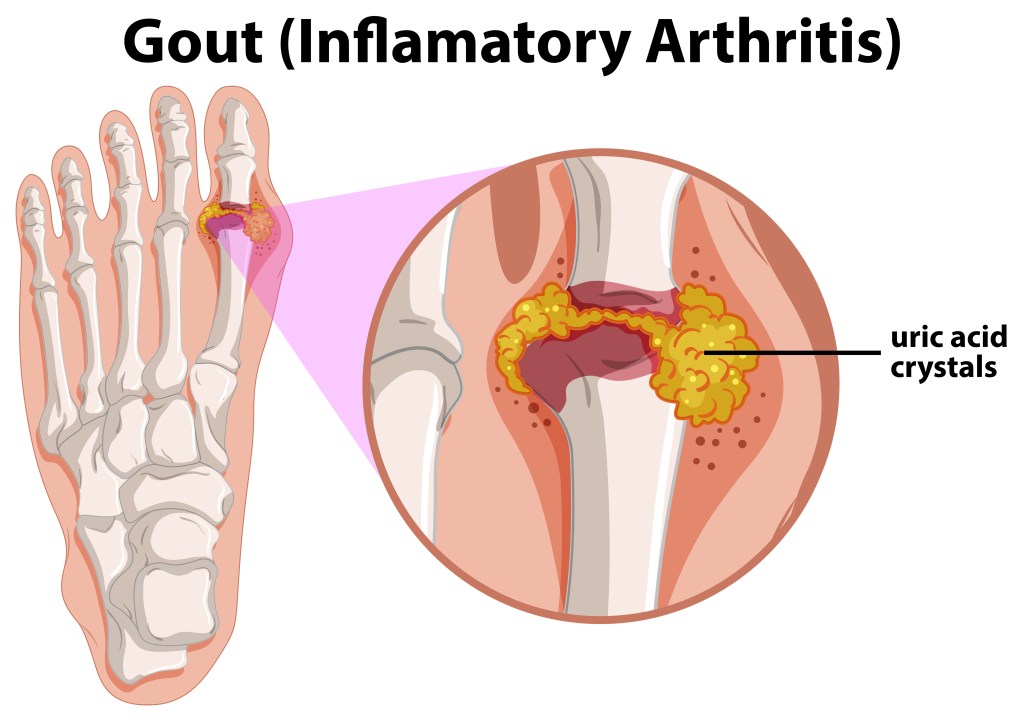At a glance
Baking soda is an effective natural remedy that may help manage gout pain and quickly relieve swelling and joint discomfort by neutralizing excess uric acid and reducing inflammation. In addition to baking soda, there are various other natural strategies to support fast gout pain relief.
Drinking baking soda water is an effective and safe remedy for gout pain. Baking soda can help alleviate swollen and inflamed joints caused by gout attacks.
Prescription medications that lower uric acid levels are typically used to treat gout flare-ups. However, these drugs can have side effects, making baking soda a safe and convenient alternative.
Let’s look at the causes of gout and how you can use baking soda to relieve gout pain.
How to use baking soda for immediate gout pain relief
Baking soda, also known as sodium bicarbonate, is an effective natural remedy for gout pain relief and avoids the common side effects of prescription medications.
Excessive uric acid, in combination with an acidic environment, stimulates the formation of uric acid crystals, which trigger gout attacks.
Baking soda is highly alkaline, counteracting acidic pH levels and neutralizing uric acid in the body. This helps to prevent uric acid crystals and relieves pain and inflammation associated with gout.
Here’s how you can use a baking soda treatment for gout relief
Mix 1/8 of a teaspoon of baking soda with eight ounces of water and stir until completely dissolved. Drink baking soda water immediately.
For immediate gout attack pain relief, consume baking soda water up to four times daily, taking one hour break in between. It’s best to avoid taking baking soda water at mealtimes as baking soda can weaken stomach acid.
If you tolerate ingesting baking soda, slowly increase the amount of baking soda to around half a teaspoon.
Some individuals are sensitive to baking soda and experience gastrointestinal issues. In this case, a topical baking soda application can be an effective alternative. Simply dissolve three tablespoons of baking soda in warm water and soak the affected joint for 20 minutes.
Watch the video below to learn how you can use baking soda to get rid of gout quickly.
What is gout?
Gout is a type of arthritis caused by elevated uric acid levels. Uric acid is a waste product of purines, an organic compound typically found in organ meats, red meats, and seafood.
Uric acid is excreted by the kidneys, but some individuals either produce too much uric acid or cannot eliminate it properly, which leads to the formation of sharp, needle-like uric acid crystals in the joints and surrounding tissue.
It’s commonly believed that the needle-like uric acid crystals cause the sudden and severe pain associated with gout attacks. However, it’s the immune response to uric acid that results in gout symptoms.
While gout typically affects the big toe, it can also develop in ankles, knees, elbows, wrists, and fingers.

What causes gout?
Research published in the Journal of Clinical & Diagnostic Research suggests that imbalanced uric acid metabolism causes gout, and it appears that individuals with insulin resistance and metabolic syndrome are at increased risk of gout attacks.1
“While some people seem to be able to combat gout with dietary and lifestyle changes, others still experience gout flare-ups despite being on a strict gout diet that avoids purine-rich foods,” says Dr. Berg.
This indicates that dietary protein doesn’t cause gout and suggests that gout is a complex metabolic condition that requires an individual approach.
Gout attacks are primarily triggered by immune cells, which cause an overt inflammatory response to uric acid, and a proinflammatory dietary pattern can significantly increase the risk of gout.
Here are some possible dietary causes linked to inflammation and gout:
- Refined carbohydrates and sugars
- Fructose and high-fructose corn syrup
- Maltodextrin
- Beer and other alcohol
- Processed food
If you suffer from persistent and recurrent gout symptoms, it’s essential to consult with your healthcare provider to rule out underlying causes and formulate an appropriate treatment plan.

Is ingesting baking soda safe?
Baking soda has several health benefits, and ingesting baking soda in moderate amounts is generally well-tolerated by most people.
However, it’s important to note that baking soda is highly alkaline, and consuming large amounts can neutralize stomach acid and lead to digestive issues.
If you experience nausea, stomach pain, or diarrhea, adjust the amount of baking soda or use a topical baking soda treatment as an alternative.
Other remedies for gout
While baking soda can be an effective and safe strategy to combat gout attacks, some individuals appear sensitive to baking soda and experience mild gastrointestinal side effects. Luckily, there are several natural alternatives to get rid of gout.
Xanthine oxidase, an enzyme that regulates purine metabolism, stimulates the formation of uric acid crystals. Blocking its activity can manage gout and prevent recurrent gout attacks.
Research published in Trends in Food Science & Technology suggests that various phytochemicals, including flavonols, terpenoids, quercetin, and alkaloids, can block xanthine oxidase and provide relief for gout sufferers.2
Here are three potent natural remedies that are rich in phytochemicals and have been found beneficial in reducing gout symptoms:
- Celery juice
- Chinese cinnamon
Gout attacks are primarily a result of immune reactions and inflammation, and boosting nutrients with potent anti-inflammatory properties is an excellent choice to manage gout symptoms and lower the risk of flare-ups.
Here are anti-inflammatory foods that may be beneficial for reducing the risk of gout attacks:
- Fatty fish such as salmon, tuna, and mackerel
- Apple cider vinegar
- Green leafy vegetables
- Berries
- Extra virgin olive oil
- Turmeric
- Seeds and nuts
According to this study published in Current Opinion in Rheumatology, “ Although gout’s cardinal feature is inflammatory arthritis, it is closely associated with insulin resistance and considered a manifestation of metabolic syndrome.” 3
This indicates that a high-carb diet, the leading cause of insulin resistance, may greatly increase the risk of gout. Following a nutrient-dense, low-carb diet like Healthy Keto® supports healthy insulin balance and is a beneficial dietary choice that can reduce your risk of gout attacks.
Key takeaways
- Baking soda can help relieve gout pain by alkalizing the body and neutralizing uric acid.
- Incorporating this natural remedy can help reduce inflammation and swelling in joints affected by gout attacks.
- For gout pain relief, take 1/8 teaspoon of baking soda in eight ounces of water up to four times daily.
- Topical baking soda soaks can help ease symptoms for those sensitive to baking soda ingestion.
- Combining baking soda use with a low-carb diet rich in anti-inflammatory foods is vital to support long-term gout management.
FAQ
1. Can baking soda reduce gout pain?
Yes, baking soda slightly alkalizes the body’s pH levels which neutralizes uric acid and prevents uric acid crystallization that triggers inflammation and painful joints during gout flare-ups.
2. Can baking soda get rid of gout?
Yes, baking soda is a natural remedy that can provide fast gout pain relief and may prevent the formation of uric acid crystals and gout symptoms such as painful and swollen joints.
3. How do I get rid of gout?
Taking baking soda drinks or using topical baking soda applications can alleviate gout symptoms.
In addition, prioritizing nutrient-dense and anti-inflammatory foods such as leafy greens, fatty fish, berries, and turmeric can help reduce uric acid levels and prevent gout flare-ups.
4. What is the fastest relief for gout pain?
Drinking baking soda water or soaking the affected joint in baking soda dilution provides fast gout relief for most people.
5. Is ingesting baking soda safe?
Yes, ingesting baking soda in moderate amounts is safe. However, if you experience nausea or gastrointestinal issues after taking baking soda, opt instead for a topical baking soda application for fast gout pain relief and consult your healthcare provider.








